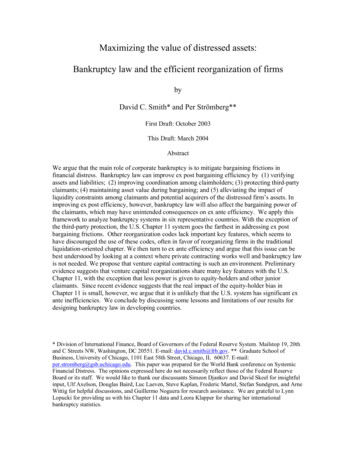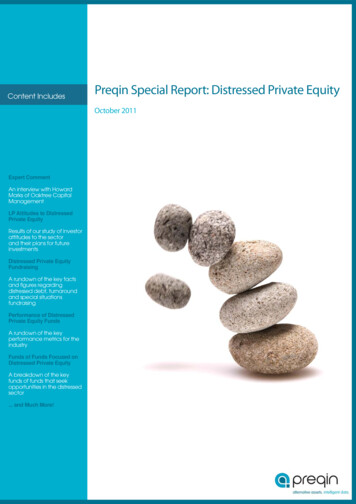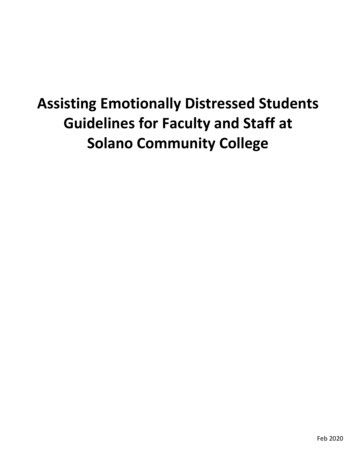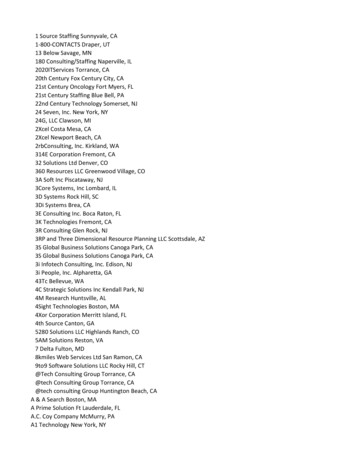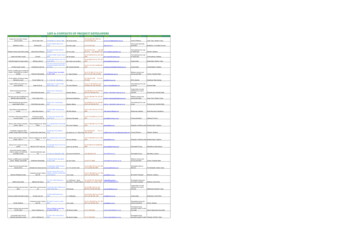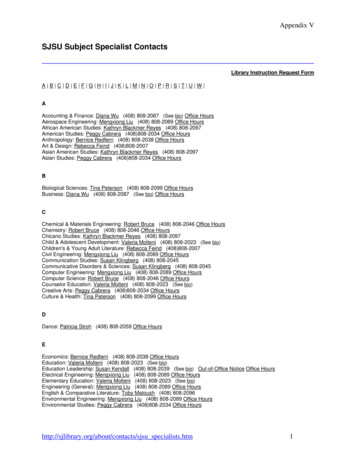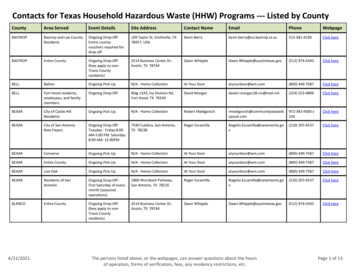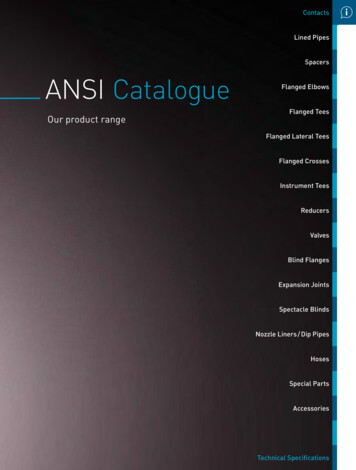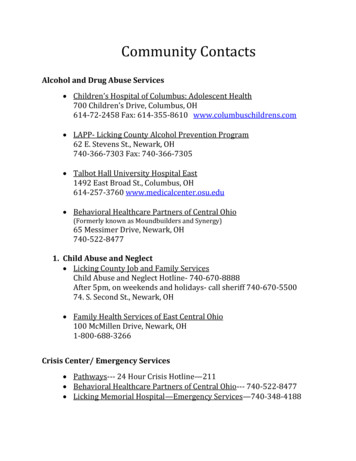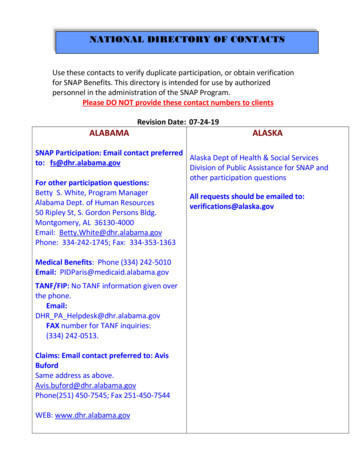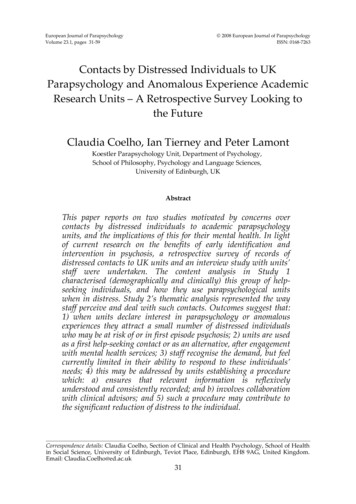
Transcription
European Journal of ParapsychologyVolume 23.1, pages 31-59 2008 European Journal of ParapsychologyISSN: 0168-7263Contacts by Distressed Individuals to UKParapsychology and Anomalous Experience AcademicResearch Units – A Retrospective Survey Looking tothe FutureClaudia Coelho, Ian Tierney and Peter LamontKoestler Parapsychology Unit, Department of Psychology,School of Philosophy, Psychology and Language Sciences,University of Edinburgh, UKAbstractThis paper reports on two studies motivated by concerns overcontacts by distressed individuals to academic parapsychologyunits, and the implications of this for their mental health. In lightof current research on the benefits of early identification andintervention in psychosis, a retrospective survey of records ofdistressed contacts to UK units and an interview study with units’staff were undertaken. The content analysis in Study 1characterised (demographically and clinically) this group of helpseeking individuals, and how they use parapsychological unitswhen in distress. Study 2’s thematic analysis represented the waystaff perceive and deal with such contacts. Outcomes suggest that:1) when units declare interest in parapsychology or anomalousexperiences they attract a small number of distressed individualswho may be at risk of or in first episode psychosis; 2) units are usedas a first help-seeking contact or as an alternative, after engagementwith mental health services; 3) staff recognise the demand, but feelcurrently limited in their ability to respond to these individuals’needs; 4) this may be addressed by units establishing a procedurewhich: a) ensures that relevant information is reflexivelyunderstood and consistently recorded; and b) involves collaborationwith clinical advisors; and 5) such a procedure may contribute tothe significant reduction of distress to the individual.Correspondence details: Claudia Coelho, Section of Clinical and Health Psychology, School of Healthin Social Science, University of Edinburgh, Teviot Place, Edinburgh, EH8 9AG, United Kingdom.Email: Claudia.Coelho@ed.ac.uk31
Contacts by Distressed Individuals to UK Academic Research UnitsIntroductionThere is, within academic parapsychology, consistent andsignificant interest in the personal and clinical significance ofdistressing anomalous or unusual experiences. Researchers andclinicians across the world (for instance, in Utrecht, Freiburg, SanFrancisco and Buenos Ayres) have studied and advanced thedevelopment of intervention models, within this context, forindividuals who seek help regarding such distressing experiences.In the UK, in the last 30 years, members of staff at the KoestlerParapsychology Unit (KPU) of the Department of Psychology,University of Edinburgh have received hundreds of requests for helpand enquiries from members of the public. Although the total numberis unrecorded, many of these individuals – probably the large majority– were happy, curious, and certainly not distressed by their anomalousexperience or belief. However, it was the policy of the KPU under thelate Professor Robert Morris, between 1986 and 2004, that if anindividual was distressed by their experience and wished to talk tosomeone, he or she was offered contact with a suitably qualifiedindividual, a clinical psychologist or psychiatrist, who gave timevoluntarily to the unit. The expressed distress was the crucial elementin these decisions. There are important similarities, but alsodifferences, between reported anomalous experiences and experienceswith a psychopathological relevance (Berenbaum, Kerns andRaghavan, 2000). As we will discuss later, we suggest that thedescription of an anomalous experience either as a paranormal eventor as the translation of mental ill-health carries unequal risks andconsequences for the affected individual.These distressed callers were often the ‘worried well’ who hadbeen frightened by an anomalous experience such ashypnagogic/pompic phenomena, were hearing unexplained sounds orvoices (in the absence of any other clinically relevant experience),feeling unexplained distressing sensations, or seeking an explanationfor unhappy coincidences. Another type of contact was made byindividuals who were delusional, often paranoid, or experiencinghallucinations, who acknowledged receiving psychiatric care. Suchindividuals were at some risk of becoming non-compliant withtreatment if persuaded that a paranormal explanation accounted for all32
Coelho, Tierney & Lamontof their experience. Occasionally, contact would also be made bydistressed individuals who would be investigating this alternative towhat the clinician believed was the early stages of a psychotic illnessbefore, or instead of, seeking advice from health professionals.Conversations between the volunteering clinicians and thecontacting individuals were unstructured. No standard approach wastaken or ‘therapy’ offered, but the clinician offered a sympathetic andinformed ear. These ‘constructive listening’ approaches, similar tothose described by Knight (2005), involved a non-judgementalacknowledgement of the person’s anomalous experience or belief.Purely listening approaches sustain the confidence of worried peopleso that discussion about their experience can take place. However, theydo not necessarily move the person on to examining the implications oftheir experience. With some individuals there is also a concern aboutcolluding with an explanation that might limit further consideration ofalternatives. The additional approach used in the KPU was toacknowledge that, as mental health professionals with an interest inparapsychological or anomalous phenomena, the clinicians involvedencouraged the affected individual to adopt a ‘scientific’ attitude totheir experience, both by recording the experiences and by exploring inparallel various explanations for their anomalous experiences.The clinical relevance of anomalous experienceAnomalous experiences are relevant to the study of individualdifference factors such as ‘eccentricity’ (Weeks & James, 1995),peculiarity (Berenbaum et al., 2000), claims of parapsychologicalexperience and psychopathology. Because these various descriptionshave varying implications for the future well-being of the individualconcerned, in practice it is their relevance to psychopathology that hasreceived most attention. The implications (both beneficial and adverse)to individuals of having their experiences interpreted primarily inpsychopathological terms have been the subject of much discussion(Bentall, 2000, 2003; Peters, Day, McKenna & Orbach, 1999; Knight,2005).Anomalous experiences (clinically described as hallucinations anddelusions) are relevant to a number of diagnoses under the twoprincipal classifications of mental or behavioural disorders – the33
Contacts by Distressed Individuals to UK Academic Research UnitsInternational Classification of Diseases 10th edition (World HealthOrganisation) (ICD-10) (1992) and the Diagnostic and StatisticalManual (of the American Psychiatric Association), 4th edition – textrevision (DSM-IV-TR) (2000). The presence of such experiences is Anecessary or core aspect a group of diagnoses including schizophrenia,schizoaffective and delusional disorders.In the last five years, there has been increasing interest amongresearchers concerned with the treatment of schizophrenia inevaluating: (a) the effects of duration of untreated psychosis (DUP),particularly in first episode; (b) the viability and benefits of earlyidentification and intervention with first episode or those experiencingputative precursor (or at-risk) stages of psychosis; and (c) strategies forimproving this early detection. In a comprehensive recent summary ofthis research (edited British Journal of Psychiatry supplement),McGorry, Nordentoft and Simonsen (2005) highlight the importanceand benefits of early and phase-specific intervention in thedevelopment of psychosis, in terms of both the overall duration andseverity of psychotic episodes. While it has been asserted that there arerisks involved in this strategy in terms of false-positive identification(Warner, 2005), recent research results suggest that the benefits to theindividuals outweigh these risks (McGlashan, 2005).The duration of untreated psychosis (DUP) is a putative period ofexperience of psychosis by an individual which is “anchored at thebeginning by onset of psychosis and at the end by initiation oftreatment” (Norman and Malla, 2001:382). DUP has been found to beinversely correlated with both short term and long term positiveoutcome measures for pharmacological and psychological treatments.In studies of the interaction between DUP and other predictors ofoutcome, such as pre-morbid functioning, DUP has been identified as astrong and potentially malleable predictor of outcome (Harrigan,McGorry & Krstev, 2003). Despite the present significant optimism anddrive in research concerning the successful early identification ofpsychosis, there are important methodological difficulties in this area,and some comparisons with standard methods of referral show nosignificant differences (Kuipers, Holloway, Rabe-Hesketh &Tennakoon, 2004). In relation to early intervention in psychosis, there isalso some evidence supporting the effective and beneficial use ofpsychological approaches to psychosis, independently or conjunctively34
Coelho, Tierney & Lamontwith established pharmacological procedures (e.g. McGorry et al.,2005).There is also interest in the evaluation of education or earlyawareness of psychosis programmes for health professionals, parentsand the general population.1 However, there seems to be littledifference in effectiveness between general population programmesversus specialist early intervention teams (Malla, Norman, Scholten,Manchanda & McLean, 2005), and the effectiveness of the latterappears to depend on the use of diagnostic tests with high specificity(Cougnard, Salmi, Salamon & Verdoux, 2005). This last study, forinstance, has estimated that, given tests of specificity greater than 88%,the numbers needing to be screened to avoid consequences in a fiveyear period would be 20,000 subjects to prevent one death, 641 toprevent one hospitalization, and 847 to prevent one unemployment.Given these large numbers, this method of early identification islaborious and expensive. Contacts by distressed individuals toparapsychology units may constitute another path to identification,which may be clinically relevant when such individuals state that theyare seeking help with frightening events or experiences.The KPU approachOver the years at the KPU it has been neither possible nor deemedappropriate to assess distressed contacting individuals in any formalway. These individuals were contacting the KPU because of the latter’sexpertise in paranormal phenomena and anomalous experienceresearch. Furthermore, standard assessments require the assessor toobserve the individual, which was not possible for the large majority ofcontacts, and to ask a large number of questions that would certainlyhave been viewed as inappropriate in this context.The KPU approach to these contacts emphasised that: a) thevarious possible explanations for anomalous experience haveimplications or degrees of risk attached for the individual; and b) thesedegrees of risk are not equal. If, for instance, the most appropriateexplanation for much of an individual’s experience was apsychopathological one, and this had not yet been assessed, then, inRespectively see: Tait, Lester, Birchwood, Freemantle & Wilson (2005); de Haan, Welborn, Krikke & Linszen(2004); Hafner, Maurer, Ruhrmann, Bechdolf, Klosterkotter, Wagner, Maier, Bottlender, Moller, Gaebel,Wolwer (2004).135
Contacts by Distressed Individuals to UK Academic Research Unitsthe light of the literature reviewed above, the sooner that explanationwas tested the better. This approach was, therefore, to acknowledgethe frightening nature of the psychopathological explanation, but toencourage the person to consider that if, after assessment by competentadvisors, that explanation was discounted, the individual could thenexplore alternative, less risk-laden explanations with greater peace ofmind. If, on the other hand, the psychopathological explanation wasappropriate, then the individual had done as much as they could toreduce the impact of a putative condition. It is believed, on ananecdotal level only, that this approach, if employed as part of athoughtful, responsive and unhurried discussion, has been useful.The present studiesThe present studies were motivated by the strong possibility that:(a) some of the distressed individuals who contact units like the KPUdo so before, or in lieu of, seeking clinical advice about their distress;and (b) these individuals may be at risk of or experiencing a psychoticillness. Thus, in light of recent research on the effect of earlyidentification and delay in the treatment of psychosis, units may have aresponsibility to offer more structured advice to such individuals.For the purpose of this project ‘Distressed Contacts’ (henceforthDCs) were defined as contacts in which individuals describe or alludeto information (verbal or behavioural) suggestive of difficulty, anxietyor distress related to experiences or abilities that the individualsconsider to be anomalous (consistent with the definition in Cardeña,Lynn and Kripner, 2000). These contacts may include an associatedrequest for information, explanation or help. Crucially, it is importantto clarify that these contacts are made by individuals approachingthese units voluntarily.MethodsAimsStudy 1 attempted to answer the following questions: (a) what is theextent of records of DCs to UK academic parapsychology/anomalousexperience research units; and (b) what information is available in36
Coelho, Tierney & Lamontthese records about; (i) such individuals, (ii) their reported experiences,and (iii) the requests that they make to these units. Study 2, aninterview study with participating academic units, aimed to provideadditional and contextual information to the data set of existingrecords (from Study 1), specifically: (a) what proportion of overall DCsto these units do existing records represent; and (b) what is the currentprocedure in each unit for dealing with such contacts.Participants and data collectionEight UK academic parapsychology/anomalous experienceresearch units, research groups or individual researchers were initiallyidentified and contacted. In addition to the KPU (host institution), fourout of seven contacted institutions agreed to participate. These were: Anomalistic Psychology Research Unit, Goldsmiths College,University of London;Consciousness and Transpersonal Research Unit, Liverpool JohnMoores University;The Parapsychology Group, Liverpool Hope University College;Perrott-Warrick Research Unit, University of Hertfordshire.It is worth noting the units which agreed to participate had bothexperience of receiving distressed contacts from members of the public,and allowed access to their existing records of such contacts. Data wascollected between April and October 2005, through: (a) theexamination of all existing records of DCs at the five participatingacademic units (records of telephone calls, letters or emails); and (b)brief research interviews with the staff member(s) of each unit mostclosely involved in dealing with such contacts.Data AnalysisStudy 1 – Analysis of recorded DCsThe records of contacts were analyzed using quantitative contentanalysis (Weber, 1990; Gibbs, 2002; Krippendorff, 2004). All existing37
Contacts by Distressed Individuals to UK Academic Research Unitsrecords of DCs (letters, e-mails and records made of telephone calls)which were provided by the five participating research units wereused, i.e. no sampling was used. The contacts’ textual content wasinitially coded according to categories pre-defined by the project’sresearch concerns: characteristics of the contacting individual (age,gender, previous contacts about the experience/ability); andcharacteristics of the contact (date, modality, frequency, reportedexperience/ability and associated distress, expressed request to theunit). The final coding units – mutually exclusive and exhaustivecategories and sub-categories, transformed into nominal independentvariables and variable levels – were tested on samples of contacts by asecond independent coder and revised according to their accuracy andreliability (Weber, 1990). The exploratory descriptive data analysisincluded tabulations (absolute and relative frequencies of occurrencesfor each variable) and cross-tabulations (frequencies of co-occurrencesbetween variables) to explore more complex interactions betweenvariables.Data consisted of all available records at this point in time. Thesewere letters, e-mails and records of telephone calls, and were collectedby different individuals during an extended period prior to the study.These individuals had an administrative, academic or a clinical role.The authors did not identify specific or systematic ostensible criteriafor the recording and keeping of these (rather than other) records ofDCs. Specifically in relation to telephone calls, records were typicallynotes taken in differing detail and produced by different individuals.Some records were based on initial, self-initiated contacts by theindividuals to the unit, typically taken by an administrative member ofstaff, including some personal characteristics of the caller (e.g. gender,age, contact details) and a broad description of the content of theexperience. Other records were based on follow-up (return) calls,initiated by one of the unit’s clinical collaborators, including greaterdetail in both personal characteristics (e.g. living circumstances,previous contacts about the experience) and the description of theexperience itself (e.g. inclusion of a description of the request for help).The available data was thus of varying quality and detail, howeverthe data was not collected or created with a view to subsequentanalysis – these were pre-existing records. The coding was naturallylimited to the available information. If the category of information was38
Coelho, Tierney & Lamontnot available, this was coded as ‘data missing’ (as will be clear in theanalysis section).Study 2 – Analysis of interview dataOnce transcripts of the interviews were produced, these wereanalyzed using computer aided thematic qualitative analysis (NVivo2.0). Thematic analysis is designed to explore, seek trends and organizetextual data in a clear and systematic way (Hayes, 1997). After the firstreading of these transcripts, it became clear that these could providenot only complementary information to that in the records, but alsoinformation on the participants’ own views about: (a) the importanceof these contacts to them and their units; (b) their willingness orperceived ability to respond to DCs; and (c) their reluctance orconcerns about responding to such contacts.ResultsStudy 1 – Analysis of recorded DCsNumber and origin of contacts: The total number of contact recordscollected across the UK units was 137. Data from the KPU representedalmost 90% of all available data (n 123). In order to preserve as muchhomogeneity in the data as possible, the following analysis includesdata gathered at the KPU only.Annual frequency, gender distribution of contacts: Over the 13 yearssurveyed by this study (1992-2005), the annual average of DCs to theKPU was close to 9 contacts per year. There is no noticeable trend(increase or decrease) in frequency of contacts during this period. Thedistribution of contacts by gender was nearly equal, male 44.7%,female 45.5% and multiple gender 7.3% (‘multiple gender’ refers tothose contacts in which the experience and distress involved more thanone individual, and that these were of different genders). When thecontact referred to experiences involving more than one individual(only 11 out of 123 contacts), 9 out
Koestler Parapsychology Unit, Department of Psychology, School of Philosophy, Psychology and Language Sciences, University of Edinburgh, UK Abstract This paper reports on two studies motivated by concerns over contacts by distressed individuals to academic parapsychology units, and t
